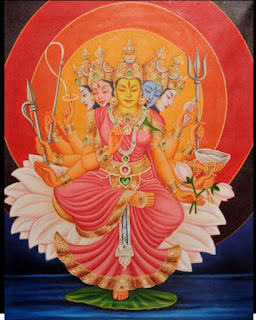विशुद्धि-चक्र-निलया(475)
Vishudi-chakra-nilaya
Vishudi chakra is also known as throat chakra. Vishudi chakra is smoky purple in colour. It appears like a sixteen petal lotus with sixteen vowels of Sanskrit with bindus (dot) inscribed on each of the petals. Each of these chakras has one predominant bija and bija for vishudi chakra is ‘ham’. This bija is white in colour and covered by akash tatwa and seated on a white elephant. This nama says ‘vishudi-chakra-nilaya’ which means ‘she resides in vishudi chakra’. But who resides in this chakra is mentioned only in nama 484, which says ‘Dakinishvari’, the name of the yogini who controls this chakra.
आरक्तवर्णा(476)
Arakthavarna
The yogini’s (Dakini) complexion is mild red.
त्रिलोचना(477)
Trilochana
Dakini has three eyes.
खट्वाङ्गादि-प्रहरणा (478)
Khatvangadi-praharana
‘Katvangam’ is a club fitted with human skull.
वदनैक-समन्विता (479)
Vadanaika-samanvita
She has a single face. The order of priority of the chakras is based upon the number of faces each yogini has. Dakini is single faced and she represents akash tatwa.
पायसान्न-प्रिया (480)
Payasanna-priya
This nama says that yogini of vishudi chakra Dakini is fond of this payasam, which is a sweet made of rice or cereal cooked with sugar and milk.
त्वक्स्था (481)
Tvakstha
She (Dakini) presides over skin and sensation of touch.
पशुलोक-भयङ्करी (482)
Pashuloka-bhanyankari
Pashu means those who are ignorant. Here ignorance means lack of knowledge about the Brahman.Dakinishwari is frightful to those who are ignorant.
अमृतादि-महा-शक्ति-संवृता (483)
Amrtadi-maha-shakthi-samvrta
Dakinishvari is surrounded by sixteen shakthis. Shakthis in this context refer to the lower level of goddesses like Amrutha, Aakarshini, etc., who are controlled by Dakinishvari. This nama says that these shakthis are powerful , "Maha shakthi ".
डाकिनीश्वरी (484)
Dakinishvari
The name of yogini who has been described from nama 475 to 484 (10 namas) is Dakinishvari, the presiding deity of vishudi chakra.
अनाहताब्ज-निलया (485)
Anāhatābja-nilayā
Anāhata cakra is known as heart cakra, which is below the throat carka or viśuddhi cakra in the heart area in the spinal cord. This cakra represents air element and yaṁ (यं) is the bīja for this cakra. Yogini who presides over this cakra is Rākiṇī.
श्यामाभा (486)
Śyāmābhā
The description of Rākiṇī now begins. She has greenish dark complexion and of sixteen years of age.
वदनद्वया (487)
Vadanadvayā
Rākiṇī has two faces.
दंष्ट्रोज्वला (488)
Daṁṣṭrojvalā
Rākiṇī has terrifying teeth (also referred as tusk) like that of a wild boar.
अक्षमालादि-धरा (489)
Akṣamālādi-dharā
Rākiṇī is wearing a garland made of fifty one beads, representing all the fifty one alphabets of Sanskrit. This cakra is capable of producing sound on its own (during deep meditation, the sound of ॐ is heard from this cakra) .
रुधिर-संस्थिता (490)
Rudhira-saṁsthitā
Rākiṇī presides over blood, the element next to the skin.
कालरात्र्यादि-शक्त्यौघवृता (491)
Kālarātryādi-śaktyaughavṛtā
Rākiṇī is surrounded by twelve of her assistants like Kālarātrī devi, each presiding over a petal.
She is said to be a form of Durgā. It is also said that on the eve of one’s death, this devi appears in dream bespeaking the death. Kālarātrī also refers to a particular night in the life of a man on the seventh day of the seventh month of the seventy-seventh year, after which period a man is exempt from attending to ordinances prescribed by dharma śāstra-s.
स्निग्धौदन-प्रिया (492)
Snigdhaudana-priyā
Rākiṇī is fond of rice mixed with ghee. This food item is capable of producing quality blood.
महावीरेन्द्र-वरदा (493)
Mahāvīrendra-varadā
Vīra mean the senses and one who wins over these Vīra -s is called vīrendra. It is also said that one who has transcended the concepts of “I” and “this” is called Vīra and she derives pleasure in granting them boons .
राकिण्यम्बा-स्वरूपिणी (494)
Rākiṇyambā-svarūpiṇī
She assumes the form of Rākiṇī, who has been described from nāma 485 to 494 (ten nāma-s).



























